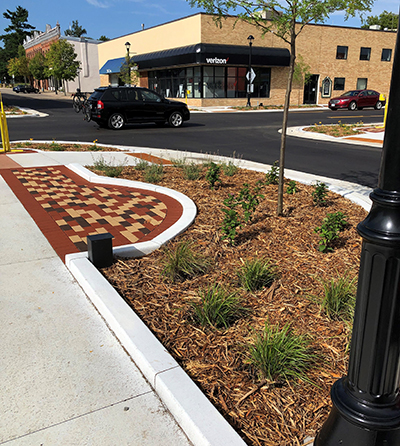
This bump-out with landscaping in Lake City provides a safer and more welcoming experience for people walking as part of the projectís Complete Streets approach. District 6 photo |
By Julie Bartkey
A Complete Street is one that is safe for everyone using the road.
MnDOT recently updated its Complete Streets policy to give clearer guidance on how to apply a Complete Streets approach in all phases of planning, scoping, project development, construction, operations and maintenance.
“The goal of Complete Streets is to design and operate an entire right of way that provides safe and convenient access for everyone who is using the road,” said Nissa Tupper, MnDOT’s Transportation and Public Health Planning Director. “For MnDOT project managers, this may mean prioritizing things like sidewalks or medians to help people walking cross safely, converting vehicle travel lanes to other uses, narrowing vehicle lanes, or changing parking configurations.”
Policy changes took effect Oct. 31. The changes prioritize safety for the most vulnerable users and encourage consistent implementation of a Complete Streets approach across the state. Changes include:
- Required Complete Streets reporting earlier in the process, starting at project planning.
- Revised responsibilities for planners, project managers, project sponsors, maintenance engineers, superintendents and supervisors, public engagement and communications professionals, and landscape architects.
- A new Project Transportation Hierarchy Tool that provides a starting point to identify user group priorities. The tool offers a process to understand user needs as they’re linked to context, safety, transportation characteristics, and plans, policies and values.
- Updated project types that are exempt from the policy. This includes some maintenance activities, landscaping or roadside infrastructure projects that don’t directly affect the layout or user mobility.
For example, when the city of Duluth completed a full reconstruction of Superior Street in 2020, a main downtown business corridor that intersects Lake Avenue, MnDOT worked with area partners to implement Complete Streets. This included new sidewalks and bringing traffic signals and pedestrian ramps into compliance with ADA requirements. Additionally, the project addressed the needs of people riding bicycles by adding a bike lane on the bridge. This is one of several project examples showcased on MnDOT’s new Complete Streets Case Studies webpage.
A new Complete Streets Handbook provides a one-stop-shop for policy procedures. It includes guidance for staff on how to implement a Complete Streets approach and comply with reporting requirements. The handbook can be found on the Complete Streets website and on iHUB.
Staff can attend an upcoming training session to fully understand how the policy update impacts day-to-day responsibilities and increase understanding of the new Complete Streets resources. Save the date for one of the training sessions, a formal announcement with registration details will follow soon:
- Nov. 29, 1-4:30 p.m. (virtual)
- Dec. 6, 1-4:30 p.m. (in person, MnDOT St. Paul Central Office)
- Dec. 12, 1-4:30 p.m. (in person, MnDOT Shoreview Training Center)
- Dec. 13, 1-4:30 p.m. (in person, MnDOT St. Cloud Training Center)
The Office of Sustainability and Public Health is now the policy owner and lead technical assistance provider on policy implementation for staff. Contact Nissa Tupper, transportation and public health planning director, at Nissa.tupper@state.mn.us, with any questions. |



